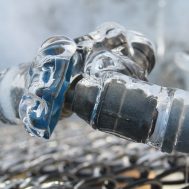Temperature performance plays a key role in a seal’s reliability, but low temperature capabilities often don’t receive the attention they deserve. When elastomeric materials encounter cold conditions, they can contract significantly, possibly compromising their sealing effectiveness and leading to leakage. Understanding how materials behave in cold environments is essential for selecting the right seal for your applications.
Understanding Low Temperature Seal Failure
Seals typically fail in cold conditions for two reasons:
First, as temperatures drop below design limits, the material becomes more and more rigid and loses its ability to adapt under pressure. This hardening creates potential leak paths because the seal can no longer adapt to surface irregularities or respond to pressure changes.
Second, seals can experience compression set, a permanent deformation that persists even after the temperature returns to normal operating conditions. This lasting change in shape can create gaps that allow leakage.
Testing Methods for Low Temperature Performance
While several standardized tests exist to evaluate material performance in cold conditions, including brittleness testing (ASTM D2137), temperature retraction (ASTM D1329), and torsional stiffness ratio (ASTM D1053), these methods don’t always translate directly to real-world applications. For example, a material might pass a brittleness test at -40°C but still become too rigid to maintain an effective seal.
The most reliable indicator for actual sealing performance is the Compression Set at Low Temperature test (ASTM D1229), which measures material recovery after cold exposure at both 3 and 30 minutes. Additionally, the Glass Transition Temperature (Tg) provides a valuable reference point, indicating when a material transitions to a more rigid state.
Material Solutions for Cold Weather Applications
Silicone-Based Materials
Vinyl Silicone (VMQ) serves as a versatile general-purpose solution, maintaining flexibility down to -80°F. For even more extreme conditions, Phenyl Silicone (PVMQ) pushes the lower limit to -130°F. However, these materials can experience significant swelling when exposed to hydrocarbon fuels and many lubricating oils.
Fluorosilicone
Fluorosilicone (FVMQ) offers an excellent balance of properties, functioning reliably down to -85°F while providing superior resistance to oils and fuels. This combination makes it particularly suitable for aerospace applications, where equipment must withstand both low temperatures at altitude and exposure to various fluids including jet fuel and de-icing agents.
Traditional Elastomers
Common elastomers can serve in moderately cold conditions when properly formulated:
- EP polymers typically perform well down to -85°F
- Specially formulated Nitrile (Buna) compounds can handle temperatures from -40°F to -85°F, though better cold performance usually comes at the cost of increased swell in oils and fuels
- Fluorocarbon (Viton™) materials operate effectively between -13°F and -40°F, with lower temperature capabilities requiring specialized polymer grades
Teflon™
For extremely cold applications, Teflon™ stands out with its ability to maintain sealing integrity down to -300°F while offering excellent gas permeation resistance. Though it lacks elastic memory and can experience creep, these limitations can be addressed through proper design considerations and the use of fillers and energizers.
Making the Right Choice
Selecting the optimal material for cold weather sealing applications requires careful consideration of multiple factors: the lowest expected temperature, exposure to chemicals or fluids, pressure requirements, and cost constraints. While higher-performance materials may carry a premium price tag, they often prove more economical in the long run by preventing failures and reducing maintenance needs.
Remember that material selection represents just one aspect of successful cold weather sealing. Proper installation, maintenance procedures, and system design all play crucial roles in ensuring reliable performance in challenging cold environments.
Questions about cold weather applications? Contact the engineers over at Apple Rubber.
